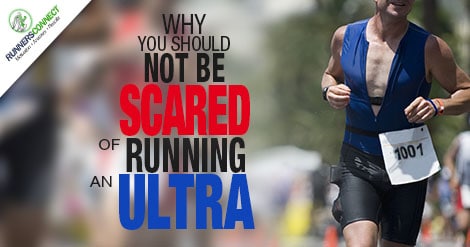Technically an ‘ultra-run’ is defined as anything longer than the standard marathon distance ggf 26.2 miles. But that’s where any similarity ends.
Terrains and distances of organized ultra events vary enormously.
There are some incredible iconic ultras all over the World, eye-watering distances and mind-blowingly extreme conditions:
Think 700km in the Yukon Arctic Ultra pulling a sledge, where ‘just surviving’ is an achievement Or the 333km ‘La Ultra’ in the Indian Himalayas, which takes runners to an altitude of 5000m.
Last year only one competitor finished.
Then there are more realistic 30 or 40 mile ‘baby’ ultras right on your doorstep, which can be a perfect introduction to this inspirational, yet slightly crazy world. But be warned, ultras are highly addictive, once you’ve done one, you could well find yourself thinking ‘just how far can I go?’

How is it possible?
Most exhausted runners who have stumbled over the finish line of a marathon, can’t even begin to imagine running one mile further, let alone another 20, 30 or even more.
How can it be possible to run 100 miles or more without stopping? Actually, it’s just relative.
When you’re new to the sport, a 10km can seem like a long way and the marathon an impossible dream. However, with patience, the right training, and by slowly building up your long run, you get there.
Training to run an ultra really isn’t much different.
‘All you have to do to run an ultra is slow down’ explains Marc Laithwaite, Endurance Coach and Race Director of the Montane Lakeland 100 Mile Trail Race in the UK.
‘Runners coming up from marathon distance find it hard to understand this concept. They have a set pace and getting them to slow down is really hard.
But it’s really simple.
You just need to slow down, reduce your heart rate and train to walk as well as run. There’s actually a lot of walking involved in ultras’.
With an ultra you can forget about PR’s, competition, or performance. They are simply about personal achievement, camaraderie and crossing the finish line.
They also generally take place in stunning locations, on spectacular trails and with amazingly friendly like-minded people who will support you, rather than race you.
‘Running has changed a lot over the last few years’ explains Marc ‘It’s becoming much more about participation, personal achievement and having an amazing experience, instead of chasing a time or bagging a new PR’.
Growing in popularity
And that ethos is driving the exponential growth in ultra running across the Globe. According to research from UltraRunning Magazine, the number of runners completing an ultra in North America alone, has increased from 15,500 in 1998 to 63,530 in 2012.
So as our lives get busier, more stressful and increasingly mundane, we have an innate desire to create lasting memories, shared experiences and to find out just how far we can push ourselves.
Ultras do just that.
The marathon is no longer the ultimate goal. Almost anyone can do it with a bit of training. Ultras on the other hand push you further than you ever thought was possible.
With that comes the most incredible sense of achievement and empowerment, not only for your running, but as a metaphor for your life.
Just how difficult is it?
The truth is that ultra runners are not super-human, they have just become really good at running slowly for a very long time.
They are very well prepared, wear the right clothes, are smart about nutrition, and have admirable mental toughness.
‘A fifty mile ultra is still a massive challenge’ explains Marc ‘but I believe that most people can do it if they commit to some proper training, simply slow down, and treat it with respect. It’s challenging but still doable for the majority of runners’.
Is it safe?
There’s no doubt, that long distance running is grueling and challenging for the body on many levels, but could you be doing any long lasting damage by pushing your body to the absolute limit?
In 2011, a group of researchers from the Stanford University School of Medicine and UC Davis launched the ‘Ultra-runners Longitudinal Tracking Study’, to assess the health of 1200 ultra runners over a 20 year period.
Baseline findings published in 2014 indicated that, somewhat unsurprisingly, ultra runners were healthier than the general US population, taking an average of only two days off work per year due to illness and with a very low prevalence of any serious medical issues.
Other key findings were that 77% of ultra runners reported an exercise related injury within the last year, which is no higher than the rate of injury in all runners (considered to be around 80%).
Notably however, only 3.7% of injuries were stress fractures, compared to 5-16% reported by other runners.
One explanation could be that due to the increased volume of walking and the terrain, ultra runners experience a reduced overall load; although there is much more work needed in that area.
There was one big concern; around 5% of runners had been hospitalized after an event over the last year (reportedly due to dehydration, electrolyte disturbance or heat exhaustion).
This is an area where scientists hope to glean more information to help educate runners of the dangers in the future.
The psychological profiles of the participants will also be studied as the researchers strive to understand what motivates ultra runners, and how this can be used to encourage others to be more active.
One thing is for sure however; we’ll be watching closely as this exciting research develops over the next few years.
Experience an ultra
Some people feel that ultra running may be safer (and more enjoyable) than road marathons or shorter distances where runners push their heart rate to maximum levels.
Most ultras take place on soft trail, rather than hard tarmac, with the varied terrain providing a more varied workout, and potentially reducing repeated loading to joints and muscles.
The pace is gentle (read about how to pace yourself), and the focus is on completion rather than competition, which makes for a more relaxed, less stressful experience.
The biggest draw for most ultra runners isn’t about the finish time.
It’s simply about the incredible experience, the discovery of just how far you can go, both physically and mentally, and the raw connection with nature, which boost endorphins far more than hammering around the track or through the streets of a city marathon.
What’s stopping you?
If the thought of an ultra is tempting you, our advice is just to go for it.
The key is simply to slow down and treat it as a jog/walk and a nice day out. Of course some of the elites will race hard at the front, but for the vast majority an ultra is an opportunity to take in the views, make some new friends, eat lots of cake and have a lovely long slow run.
To find an event, have a look at Ultra Marathon Running which has almost every Ultra Marathon in the World listed.
Check back in a few weeks for our next post on how to train for an ultra. In the meantime, you can listen to our podcast episode with Ultra runner Podcast host Eric Schranz.






